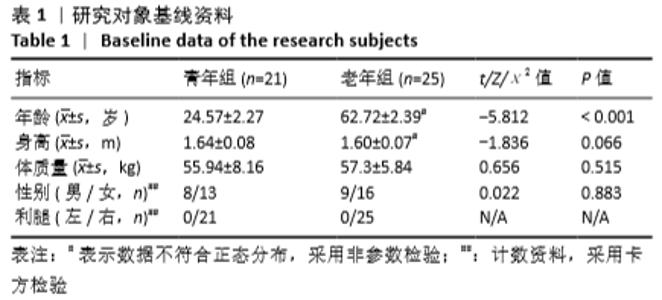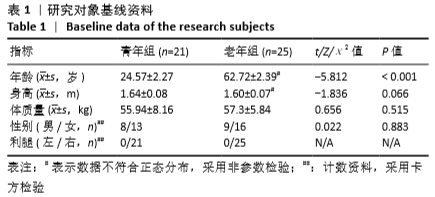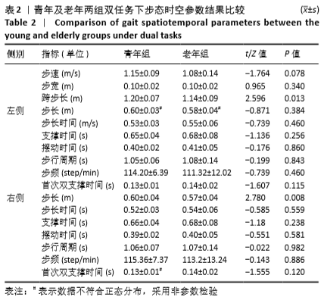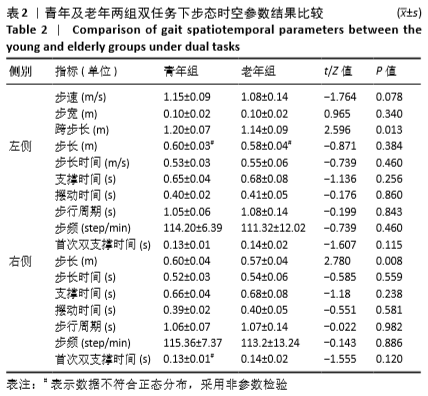Chinese Journal of Tissue Engineering Research ›› 2021, Vol. 25 ›› Issue (3): 344-349.doi: 10.3969/j.issn.2095-4344.2967
Previous Articles Next Articles
Comparison of gait characteristics between young and elderly people under dual tasks using three-dimensional gait analysis
Yang Fengjiao1, 2, Wang Xiangbin1, 2, 3, Hou Meijin1, 2, Yu Jiao4, Li Zhenhui1, 2, Fu Shengxing1, 2, Lin Ziling1, 2, Liu Benke1, 2
- 1Fujian University of Traditional Chinese Medicine, Fujian Province, China; 2Key Laboratory of the Ministry of Education of Bone Injury and Sports Rehabilitation of Traditional Chinese Medicine, Fujian Province, China; 3Third People’s Hospital Affiliated to Fujian University of Traditional Chinese Medicine, Fujian Province, China; 4Department of Rehabilitation Medicine, Longyan First Hospital, Fujian Medical University, Fujian Province, China
-
Received:2020-03-11Revised:2020-03-16Accepted:2020-05-13Online:2021-01-28Published:2020-11-16 -
Contact:Wang Xiangbin, Professor, Doctoral supervisor, Fujian University of Traditional Chinese Medicine, Fuzhou 350122, Fujian Province, China; Key Laboratory of the Ministry of Education of Bone Injury and Sports Rehabilitation of Traditional Chinese Medicine, Fuzhou 350122, Fujian Province, China; Third People’s Hospital Affiliated to Fujian University of Traditional Chinese Medicine, Fuzhou 350122, Fujian Province, China -
About author:Yang Fengjiao, Master candidate, Fujian University of Traditional Chinese Medicine, Fuzhou 350122, Fujian Province, China; Key Laboratory of the Ministry of Education of Bone Injury and Sports Rehabilitation of Traditional Chinese Medicine, Fuzhou 350122, Fujian Province, China -
Supported by:the National Natural Science Foundation of China, No. 81774384; the Open Project of Fujian Rehabilitation Industry Research Institute, No. 2015Y2001-55; the Leading Project of Science and Technology Department of Fujian Province, No. 2017Y0046; the Management Project of Fujian University of Traditional Chinese Medicine, No. X2017020
CLC Number:
Cite this article
Yang Fengjiao, Wang Xiangbin, Hou Meijin, Yu Jiao, Li Zhenhui, Fu Shengxing, Lin Ziling, Liu Benke. Comparison of gait characteristics between young and elderly people under dual tasks using three-dimensional gait analysis[J]. Chinese Journal of Tissue Engineering Research, 2021, 25(3): 344-349.
share this article
Add to citation manager EndNote|Reference Manager|ProCite|BibTeX|RefWorks
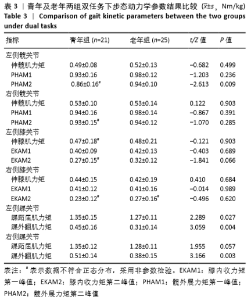
2.3 老年组与青年组双任务下步态动力学参数的比较 表3示,双任务下老年组左侧髋外展肌力矩第二峰值(second peak hip abductor moment,PHAM2)高于青年组(P < 0.01,effect size=0.600)、左侧踝跖屈肌力矩低于青年组(P < 0.05,effect size=0.608)、左右两侧踝外翻肌力矩低于青年组(P < 0.01,effect size=0.931;P < 0.01,effect size=0.896),其余参数如左右侧伸髋肌力矩、左右侧髋外展力矩第一峰值(first peak hip abductor moment,PHAM1)等未见统计学差异(P > 0.05)。"
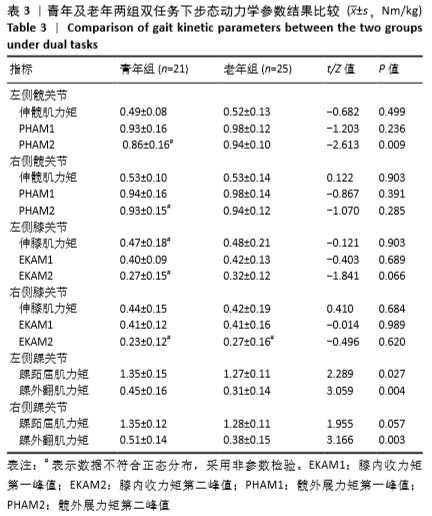
| [1] MUIR-HUNTER SW, WITTWER JE. Dual-task testing to predict falls in community-dwelling older adults: a systematic review. Physiotherapy. 2016; 102(1):29-40. [2] LUNDIN-OLSSON L, NYBERG L, GUSTAFSON Y. “Stops walking when talking” as a predictor of falls in elderly people. Lancet.1997;349(9052):617. [3] COMMANDEUR D, KLIMSTRA MD, MACDONALD S, et al. Difference scores between single-task and dual-task gait measures are better than clinical measures for detection of fall-risk in community-dwelling older adults. Gait Posture.2018;66:155-159. [4] HERSSENS N, VERBECQUE E, HALLEMANS A, et al. Do spatiotemporal parameters and gait variability differ across the lifespan of healthy adults? A systematic review. Gait Posture.2018;64: 181-190. [5] LAUFER Y. Effect of age on characteristics of forward and backward gait at preferred and accelerated walking speed. J Gerontol A Biol Sci Med Sci. 2005;60(5):627-632. [6] ABOUTORABI A, ARAZPOUR M, BAHRAMIZADEH M, et al. The effect of aging on gait parameters in able-bodied older subjects: a literature review. Aging Clin Exp Res.2016;28(3): 393-405. [7] SMITH E, CUSACK T, CUNNINGHAM C, et al. The Influence of a Cognitive Dual Task on the Gait Parameters of Healthy Older Adults: A Systematic Review and Meta-Analysis. Journal of Aging and Physical Activity. 2017; 25(4):671-686. [8] QU X. Age-related cognitive task effects on gait characteristics: do different working memory components make a difference?. J Neuroeng Rehabil.2014;11:149. [9] HOLLMAN J H, KOVASH FM, KUBIK JJ, et al. Age-related differences in spatiotemporal markers of gait stability during dual task walking. Gait Posture.2007;26(1):113-119. [10] STUART S, ALCOCK L, ROCHESTER L, et al. Monitoring multiple cortical regions during walking in young and older adults: Dual-task response and comparison challenges. Int J Psychophysiol. 2019;135:63-72. [11] KIKKERT L, VUILLERME N, VAN CAMPEN J P, et al. The relationship between gait dynamics and future cognitive decline: a prospective pilot study in geriatric patients. Int Psychogeriatr.2018;30(9):1301-1309. [12] TOMBU M, JOLICOEUR P. A central capacity sharing model of dual-task performance. J Exp Psychol Hum Percept Perform.2003;29(1):3-18. [13] MCGRATH R L, ZIEGLER ML, PIRES-FERNANDES M, et al. The effect of stride length on lower extremity joint kinetics at various gait speeds. PLoS One.2019;14(2):e200862. [14] KO SU, JEROME GJ, SIMONSICK EM, et al. Differential associations between dual-task walking abilities and usual gait patterns in healthy older adults-Results from the Baltimore Longitudinal Study of Aging. Gait Posture.2018;63:63-67. [15] MOYER RF, RATNESWARAN A, BEIER F, et al. Osteoarthritis year in review 2014: mechanics--basic and clinical studies in osteoarthritis. Osteoarthritis Cartilage.2014;22(12):1989-2002. [16] PAQUETTE MR, ZHANG S, MILNER CE, et al. Effects of increased step width on frontal plane knee biomechanics in healthy older adults during stair descent. Knee.2014;21(4):821-826. [17] SONG Q, TIAN X, WONG D, et al. Effects of Tai Chi Exercise on body stability among the elderly during stair descent under different levels of illumination. Res Sports Med.2017;25(2):197-208. [18] DEMURA T, DEMURA S, UCHIYAMA M, et al. Examination of factors affecting gait properties in healthy older adults: focusing on knee extension strength, visual acuity, and knee joint pain. J Geriatr Phys Ther.2014;37(2):52-57. [19] GUADAGNIN E C, DA RE, MOTA CB, et al. Effects of regular exercise and dual tasking on spatial and temporal parameters of obstacle negotiation in elderly women. Gait Posture.2015;42(3):251-256. [20] ALARCON R, NALPAS B, PELLETIER S, et al. MoCA as a Screening Tool of Neuropsychological Deficits in Alcohol-Dependent Patients. Alcohol Clin Exp Res.2015;39(6):1042-1048. [21] AIONA M, DO KP, EMARA K, et al. Gait patterns in children with limb length discrepancy. J Pediatr Orthop.2015;35(3):280-284. [22] CAPPOZZO A, CATANI F, CROCE U D, et al. Position and orientation in space of bones during movement: anatomical frame definition and determination[J]. Clin Biomech (Bristol, Avon), 1995;10(4):171-178. [23] AL-YAHYA E, DAWES H, SMITH L, et al. Cognitive motor interference while walking: a systematic review and meta-analysis. Neurosci Biobehav Rev. 2011;35(3):715-728. [24] BONETTI LV, HASSAN SA, KASAWARA KT, et al. The effect of mental tracking task on spatiotemporal gait parameters in healthy younger and middle- and older aged participants during dual tasking. Exp Brain Res. 2019;237(12): 3123-3132. [25] 黄萍,钟慧敏,陈博,等.正常青年人三维步态:时空及运动学和运动力学参数分析[J].中国组织工程研究, 2015,19(24):3882-3888. [26] A G, US N. The effect of age on variability in gait. J Gerontol.1984;39(6): 662-666. [27] 刘立,张庭然,罗炯,等.老年人与年轻人双重任务下阶梯行走步态特征比较[J].中国康复理论与实践, 2020,26(3):285-290. [28] PRIEST AW, SALAMON KB, HOLLMAN JH. Age-related differences in dual task walking: a cross sectional study. J Neuroeng Rehabil.2008;5:29. [29] AGNER S, BERNET J, BRULHART Y, et al. Spatiotemporal gait parameters during dual task walking in need of care elderly and young adults. A cross-sectional study. Z Gerontol Geriatr. 2015;48(8):740-746. [30] KIM SJ, CHO SR, YOO GE. The Applicability of Rhythm-Motor Tasks to a New Dual Task Paradigm for Older Adults. Front Neurol.2017;8:671. [31] DUCHARME SW, SANDS CJ, MOORE CC, et al. Changes to gait speed and the walk ratio with rhythmic auditory cuing. Gait Posture.2018;66:255-259. [32] EIKEMA DJ, FORRESTER LW, WHITALL J. Manipulating the stride length/stride velocity relationship of walking using a treadmill and rhythmic auditory cueing in non-disabled older individuals. A short-term feasibility study. Gait Posture.2014;40(4):712-714. [33] HEITMANN DK, GOSSMAN MR, SHADDEAU SA, et al. Balance performance and step width in noninstitutionalized, elderly, female fallers and nonfallers. Phys Ther.1989;69(11):923-931. [34] VERGHESE J, WANG C, LIPTON RB, et al. Quantitative gait dysfunction and risk of cognitive decline and dementia. J Neurol Neurosurg Psychiatry. 2007; 78(9):929-935. [35] ARVIN M, van DIEEN J H, FABER GS, et al. Hip abductor neuromuscular capacity: A limiting factor in mediolateral balance control in older adults?. Clin Biomech (Bristol, Avon). 2016;37:27-33. [36] PORTO JM, FREIRE JR, BOCARDE L, et al. Contribution of hip abductor-adductor muscles on static and dynamic balance of community-dwelling older adults. Aging Clin Exp Res. 2019;31(5): 621-627. [37] DAVIS LA, ALLEN SP, HAMILTON LD, et al. Differences in postural sway among healthy adults are associated with the ability to perform steady contractions with leg muscles. Exp Brain Res. 2020;238(2):487-497. [38] ROGAN S, TAEYMANS J, BANGERTER C, et al. Influence of single and dual tasks on gait stability and gait speed in the elderly : An explorative study. Z Gerontol Geriatr.2019;52(1):23-27. [39] NIEBOROWSKA V, LAU ST, CAMPOS J, et al. Effects of Age on Dual-Task Walking While Listening. J Mot Behav.2019;51(4):416-427. [40] SIMIC M, HINMAN RS, WRIGLEY TV, et al. Gait modification strategies for altering medial knee joint load: a systematic review. Arthritis Care Res (Hoboken).2011;63(3):405-426. [41] FUKAYA T, MUTSUZAKI H, MORI K. Relations between external moment and movement of the knee joint during the stance phase in patients with severe knee osteoarthritis. J Orthop. 2019;16(1): 101-104. [42] KITO N, SHINKODA K, YAMASAKI T, et al. Contribution of knee adduction moment impulse to pain and disability in Japanese women with medial knee osteoarthritis. Clin Biomech (Bristol, Avon). 2010;25(9):914-919. [43] DEVITA P, HORTOBAGYI T. Age causes a redistribution of joint torques and powers during gait. J Appl Physiol (1985). 2000;88(5):1804-1811. [44] JUDGE J O, UNDERWOOD M, GENNOSA T. Exercise to improve gait velocity in older persons. Arch Phys Med Rehabil.1993;74(4):400-406. [45] KERRIGAN D C, TODD M K, DELLA C U, et al. Biomechanical gait alterations independent of speed in the healthy elderly: evidence for specific limiting impairments. Arch Phys Med Rehabil. 1998;79(3):317-322. [46] PETERS M. Footedness: asymmetries in foot preference and skill and neuropsychological assessment of foot movement. Psychol Bull.1988; 103(2):179-192. [47] HIRASHIMA K, HIGUCHI Y, IMAOKA M, et al. Dual-tasking over an extended walking distance is associated with falls among community-dwelling older adults. Clin Interv Aging.2015;10:643-648. [48] KRIBUS-SHMIEL L, ZEILIG G, SOKOLOVSKI B, et al. How many strides are required for a reliable estimation of temporal gait parameters? Implementation of a new algorithm on the phase coordination index. PLoS One.2018;13(2):e192049. |
| [1] | Wang Xinting, Xu Dandi, Zhang Junxia, Su Hailong Wang Qi. Stability of load-bearing cross barrier of different arch structures [J]. Chinese Journal of Tissue Engineering Research, 2021, 25(24): 3838-3843. |
| [2] | Jiang Hai, Yu Yu, Liu Zhicheng, Zhang Qiliang. Treatment of plantar fasciitis with extracorporeal shock wave and corticosteroid injection: comparison of plantar pressure and gait [J]. Chinese Journal of Tissue Engineering Research, 2021, 25(21): 3286-3291. |
| [3] | Li Yang, Jiang Shuyun, Li Yiying, Yu Yan, Lu Xiaoying, Wang Danci . Spatiotemporal, kinematic and kinetic characteristics of gait in children with genu valgus [J]. Chinese Journal of Tissue Engineering Research, 2021, 25(15): 2303-2308. |
| [4] | Zhao Weibiao, He Ziwei, Li Ji, Li Yi. Application value of 3D printing guide plate in SuperPATH technology for elderly hip arthroplasty: retrospective study and evidence analysis of literature retrieval [J]. Chinese Journal of Tissue Engineering Research, 2020, 24(9): 1324-1330. |
| [5] | Liu Qun, Sun Dongdong, Gao Lilan, He Zhijiang, Sun Minglin. Risk factors for fractures secondary to percutaneous kyphoplasty: a meta-analysis [J]. Chinese Journal of Tissue Engineering Research, 2020, 24(6): 976-984. |
| [6] | Xie Hui, Chen Haopeng, Wang Benjie, Fu Weimin, Zhao Dewei. Effect of different distribution types of bone cement after percutaneous kyphoplasty on osteoporotic vertebral compression fractures at different sites [J]. Chinese Journal of Tissue Engineering Research, 2020, 24(28): 4505-4510. |
| [7] |
Zheng Haijun, Jin Hui, Cui Hongling, Zhu Yakun, Zeng Hui, Han Fengjie, Qiu Cuiting, Liu Jing.
Safety of drug-coated balloon versus drug-eluting stents in the treatment of type 2 diabetes mellitus complicated by coronary artery small vessel disease in older adult patients [J]. Chinese Journal of Tissue Engineering Research, 2020, 24(28): 4573-4579. |
| [8] | Hu Zhengxia, Lan Hai, Yuan Jin, Li Kainan. Total hip arthroplasty for senile femoral neck fractures: SuperPATH approach versus traditional posterolateral approach [J]. Chinese Journal of Tissue Engineering Research, 2020, 24(24): 3834-3839. |
| [9] | Zhao Jing, Yin Lian, Lei Xuemei, Li Miaomiao, Wang Kun, Zhang Tingran, Luo Jiong. KAASTU training for muscle fitness in the middle-aged and elderly adults: effects and strengths [J]. Chinese Journal of Tissue Engineering Research, 2020, 24(23): 3737-3743. |
| [10] | Huang Zhaoguo, Zhang Caiyi, Zhang Qing, Wang Sheng, Wang Shaogang, Li Jun, Tao Zhongliang, Zuo Caihong. Curative efficacy of proximal femoral nail antirotation versus intertrochanteric antegrade nail for treating intertrochanteric fracture in older adults [J]. Chinese Journal of Tissue Engineering Research, 2020, 24(21): 3310-3314. |
| [11] | Gao Zhaopeng, Gao Ming, Jiang Zhen, Zhang Qinming, Jia Dailiang, Wang Haibin. Hemostatic and anticoagulant effects of proximal femoral nail anti-rotation in repairing elderly patients with intertrochanteric fractures during perioperative period [J]. Chinese Journal of Tissue Engineering Research, 2020, 24(21): 3315-3320. |
| [12] | Tian Lu, Liu Bin. Effects of physical activity and exercise on metabolic syndrome [J]. Chinese Journal of Tissue Engineering Research, 2020, 24(2): 296-302. |
| [13] | Chen Haopeng, Xie Hui, Fu Weimin, Wang Benjie, Zhao Dewei. Effect of body mass index on the early-term hip functional recovery after total hip arthroplasty by three-dimensional gait analysis [J]. Chinese Journal of Tissue Engineering Research, 2020, 24(18): 2842-2847. |
| [14] | Wang Kexin , Fan Jiang, Li Xue, Yang Shan, Ren Dong, He Chengqi. Long-term intensive family rehabilitation training for postoperative functional recovery in elderly hip fracture patients [J]. Chinese Journal of Tissue Engineering Research, 2020, 24(14): 2158-2163. |
| [15] | He Yuanyuan, Ding Chengbiao, Zhang Weiwei, Yan Guang, Sun Mengwen. Plantar pressure changes in older people with sarcopenia [J]. Chinese Journal of Tissue Engineering Research, 2020, 24(14): 2223-2228. |
| Viewed | ||||||
|
Full text |
|
|||||
|
Abstract |
|
|||||
